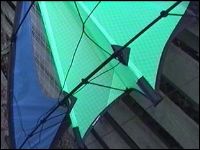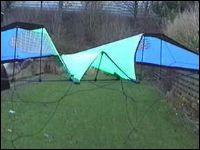So…. Could the Benson/Wardley duo really follow up their previous success?
But before we get in to the details from 2001, I’d like to share a brand new video with a pile of fresh close-ups of the famous kite. Are you ready?
Build Quality
Close inspections reveal that the build quality is close to immaculate as expected from Mr Benson, though one of the knots on the bridle had come loose and I had to re-tie it. (The same happened on a Gemini from the same shipment too.) However, this was easily fixed and the kite was ready for air.
The MiniGem is – as its name implies – a smaller version of the Gemini (wingspan approx 185cm). It’s an all-out trick kite aimed for those days when the wind is picking up.
The dual spine construction is there, and so are the five standoffs W-shaping the trailing edge. The panel layout is a tad simpler than on its big-brother with a couple of panels less. The sail is mylar reinforced at the appropriate places. Mylar is also being used in the “eyes” panels in the creating a sexy visual effect when the sun is shining through it. Cool!
The bridle is the active X as found on the Gemini. The only drawback AFAIC is that the bridle lines have a tendency to wear at the two crossing points. However, that’s a minor catch compared to the major positive impact this bridle has on the kite.
Assembly is a tad more cumbersome than on other kites. Every time I take it out of the bag the standoffs and bridle lines are in a total mess! 😉 Some sorting out is needed before assembly. When assembling the lower spreaders make sure the bridle is not tangled. There are a lot of lines!
…but HEY! The MiniGem now comes with an instruction card!
Flight Characteristics
OK, you might need a minute or two extra to assemble the MiniGem, but as soon as it’s airborne, these minutes definitely are worthwhile. The kite looks really good in the air, and the mylar panels make a great visual effect.
The first thing you’ll notice is that the MiniGem generates very little pull, thus making it very suited in higher winds (up to a certain limit of course). The next is that this kite is begging for tricks! It’s quick and agile and when you get your reflexes together, it keeps its trickability even in higher winds.
Precision
The MiniGem is definitely a trick kite. But… I must admit I’m a bit impressed by its general precision qualities. I’m not saying this is a precision kite, so if you’re looking for that sort of thing, you need to look elsewhere. But the kite can do pretty steady trajectories and snappy 90° turns. You need to be careful though. Not a lot of input is required, so you should use subtle movements, or else you’ll overdo it.
The MiniGem does pretty good stalls and sliding stalls as well. You need to tend the sliding stall, but with the necessary input, I was able to make it slide it more than half of the wind window.
Snapstalls are a bit touchy. Too sloppy and the kite will not hold the stall. With snappy and (very) quick hand movements (and body movement too if required,) snap stalls are very much in reach.
I must say that for a kite this trickable, it’s precision qualities are good!
Freestyle/Trick
This kite will do all the tricks in the book! …and maybe even a handful more!
The MiniGem does predictable turns and tight spins are well within its wingtip. Not much height is lost during these tight spins. I also found it surprisingly easy to exit tight spins in the requested direction. Not always an easy task on such a tight spinning kite!

All groundwork is carried with ease due to the (very) curved leading edges and its smallish size. Sleeping Beauties comes almost automatically. Tip wraps could be shaken loose most of the times.
Axels and axel combinations are also done almost effortlessly. Cascades, FlipFlops and Up-The-Fountains are easily linked and come in by numbers, and due to the kite’s light pull, forward body movement can be limited.
The MiniGem is happy doing horizontal rotations. This comes in handy when doing all kinds of flat spins. 180’ies and 540ies can be executed quick and aggressively or slow and gracefully depending on your input (and flying style). I even managed a couple of 900’s!
These horizontal rotations are equally accessible with the kite on it’s back. Very handy when backspinning. And boy does this kite backspin!
I found Lazy Susans being a tad more tricky. The nose must be pointed well downwards before starting the rotation. If the nose didn’t point down, the initiating pop just seemed to pull the kite backwards.
Another way is to backflip the kite a bit uneven. The uneven release will initiate the rotation immediately, easing the whole move.
Vertical rotations are a doddle making fade entries second nature! FlicFlacs and FadeFlacs like ways. By abruptly pulling on the lines while the kite in a pancake position and immediately giving lots of slack would rotate the kite vertically 360° setting up for quite a few spectacular rollups.
I also found the MiniGem a lot easier to overrotate a backflip setting up for a Fruit Rollup. Actually I was successfully doing these rollups like on no other kite I’ve flown!
I noticed a few more “walks of shame” (or better: “walks of thoughts!”) than I normally do when flying, and the MiniGem is probably not the best kite to dead launch despite it’s (very) curved leading edges.
However, I think this situation occurred more frequently than normal because this kite really begs for you to throw tricks at it and I guess I overdid it on several (!!!) occasions.
Conclusion
If you’re looking for:
- a kite that will do all the tricks in the book, and a few more…
- …a kite that can handle a bit of wind…
- …a kite that still can do precision to some extent…
- …and you don’t mind its smallish size
…then you will never regret adding a Benson MiniGem to your kite collection!
The Benson/Wardley duo has putt another success under their belt!!
| Characteristics | ADC’s Rating |
| Skill Level | 🙂 🙂 🙂 🙂 |
| Pull | 🙂 🙂 |
| Precision | 🙂 🙂 🙂 |
| Trickability | 🙂 🙂 🙂 🙂 🙂 |
| Build Quality | 🙂 🙂 🙂 🙂 |
Conditions
This review is based on my first test flight, a three hours session in pretty steady wind conditions varying between 4-5 m/sec.

- This article was originally published on AERIALIS-DOT-COM by Sven Arnesen, March 2001.
- The Featured Image is a photo of its big brother, the Gemini – and will be updated whenever I get my act together and take a photo of the MiniGem!








